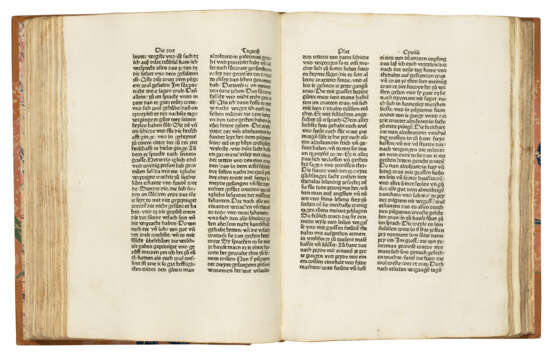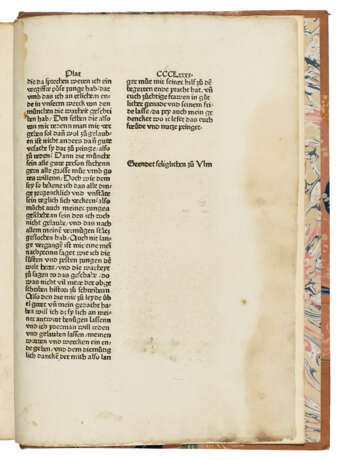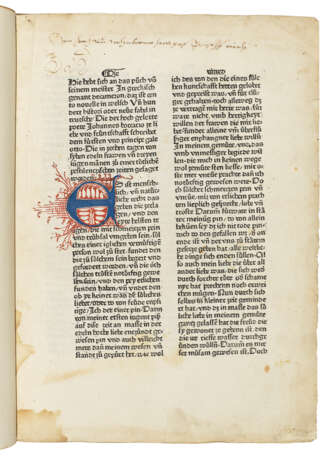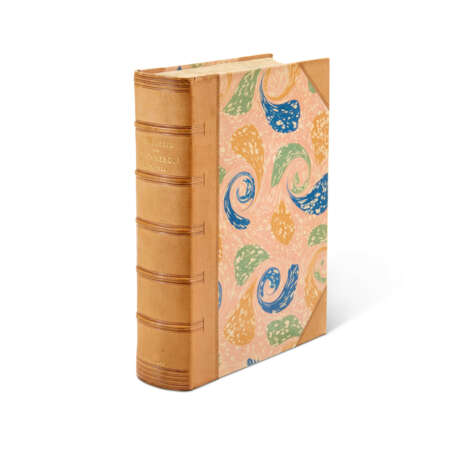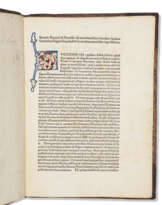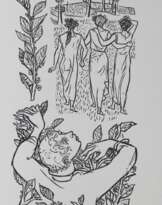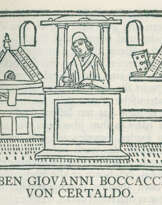ID 1249777
Lot 124 | BOCCACCIO, Giovanni (1313-1375)
Valeur estimée
£ 50 000 – 80 000
Decamerone, in German. Translated by Arigo (i.e. Heinrich Schlüsselfelder?). Ulm: [Johann Zainer, about 1476].
First edition of Boccaccio's Decamerone in German, extremely rare, with no copies in RBH auction records, and only 12 copies (4 mere fragments) listed in ISTC. No copy of any earlier edition of the Decameron has been offered at auction in over 70 years.
The Ulm Decameron is one of the earliest published translations of a literary work from one vernacular language into another. The translator of this edition, who is named as Arigo, holds an important position in the development of German prose due to his work here, however his identity has not yet been determined beyond doubt. An entry in a manuscript by Vadiana in St. Gallen mentions the name of Heinrich Schlüsselfelder from Nuremberg who worked as a translator and was called 'Blumen der Tugen'; this has led some scholars to suggest this is Arigo, however the names of Heinrich Steinhöwel and Heinrich Leubing have also been suggested (see J.L. Flood in Book Production and Letters in the Western European Renaissance: Essays in Honour of C. Fahy, London, 1986, pp.64-88).
This pioneering German edition was used in the 16th century by the German poet and composer Hans Sachs (1494-1576) as a source of inspiration for his carnival plays (Fastnachtsspiele): ‘The work of Boccaccio which Sachs used the most extensively of all was the Decameron, in the translation of the mysterious ‘Arigo’ [...] The reception of the Decameron (as a complete work) in Germany begins with the publication of Arigo’s translation by Johann Zainer at Ulm in 1472 or 1473 or, according to (debatable) typographical evidence adduced by Peter Amelung as late as 1476-78. Who Arigo was is not clear. It is certain that he was a German, and until recently it was believed he came from Nuremberg’ (Hans Sachs and the Folk Theater in the Late Middle Ages. Studies in the History of Popular Culture, Lewiston, New York, 1995, p. 143-145). Goff and GW date the edition to c.1473 but BSB and CIBN date it to c.1476, following Amelung (somewhat doubted by Flood).
ISTC records only 12 copies, of which one is lost, 3 are imperfect and 2 are fragments only; only one copy is in America (PML). The present copy, like that at the British Library, includes the colophon (on leaf X10r) ‘Geendet seliglichen zů Ulm’, other variants do not include the place of printing. Goff B-730 (without imprint); BMC II 520 (with imprint); GW 4451 (without imprint; collation: a-z10.8,A-V8.10 X10 ); BSB-Ink B-566; CIBN B-529; H 3279*=3280 (without imprint); Amelung, Frühdruck, I pp.18, 44; ISTC ib00730000.
Median folio (333 x 234mm). 395 leaves (of 398, lacking a9 and e9 and without first blank leaf). Gothic type, partly foliated, 6-line initial in blue and red on first leaf of text, other initial spaces blank (H3 with neat tear just into text, X8 top corner torn with loss of a few letters, some marginal worming repaired, some water- and dampstaining, mould spots in final few quires, occasional dust-stains). Early 20th-century half pale pigskin by royal binder Gustaf Hedberg of Stockholm [see identical binding on Euclid, also from the library of baron Per Hierta lot 129], spine in six compartments with raised bands, marbled paper boards. Provenance: early inscription at head of first leaf 'Den hoch und wolgeborene herrn graf Christoff [?]' – old inscription removed from head of a3 [illegible] – Baron Per Hierta (Swedish bibliophile, 1864-1924; manuscript note in ink on preliminary blank dated 1903).
| Artiste: | Giovanni Boccaccio (1313 - 1375) |
|---|---|
| Lieu d'origine: | Europe de l'Ouest, Allemagne, Europe |
| Catégorie maison de vente aux enchères: | Livres et manuscrits, Livres imprimés |
| Artiste: | Giovanni Boccaccio (1313 - 1375) |
|---|---|
| Lieu d'origine: | Europe de l'Ouest, Allemagne, Europe |
| Catégorie maison de vente aux enchères: | Livres et manuscrits, Livres imprimés |
| Adresse de l'enchère |
CHRISTIE'S 8 King Street, St. James's SW1Y 6QT London Royaume-Uni | |
|---|---|---|
| Aperçu |
| |
| Téléphone | +44 (0)20 7839 9060 | |
| Commission | see on Website | |
| Conditions d'utilisation | Conditions d'utilisation |
